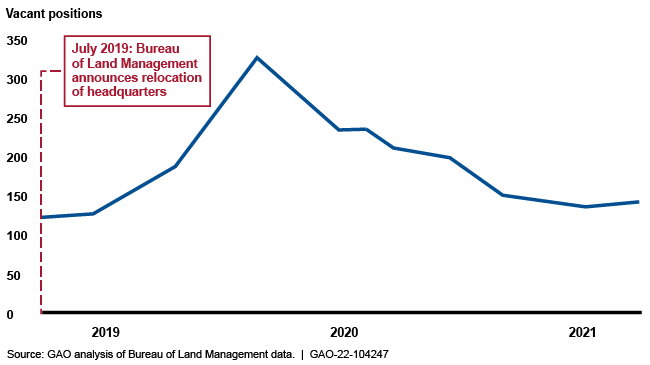Bureau of Land Management: Better Workforce Planning and Data Would Help Mitigate the Effects of Recent Staff Vacancies
Fast Facts
After the Bureau of Land Management announced in July 2019 that it was relocating its headquarters from Washington, D.C., to Grand Junction, Colorado, many headquarters staff left the agency—increasing vacancies by about 169%.
Bureau staff said that the vacancies caused problems with completing their duties. For example, because key decision makers at headquarters left, there were delays in creating or clarifying guidance and policy.
We also found that the Bureau didn't have a strategic workforce plan that could help address the issues resulting from these vacancies. We recommended that the Bureau develop an agency-wide strategic workforce plan.
Bureau of Land Management Headquarters Vacancies from July 2019 to May 2021

Highlights
What GAO Found
Since 2016, the Department of the Interior's Bureau of Land Management (BLM) changed its organizational structure by merging or transferring several of its headquarters functions. BLM also moved its headquarters from Washington, D.C., to Grand Junction, CO, and relocated most of its headquarters positions to its new headquarters and other offices in 11 western states. In September 2021, the Secretary announced plans to return the headquarters to Washington, D.C.
Since 2016, BLM's workforce composition changed in several ways, including through increases in headquarters vacancies and in temporary reassignments—known as details—to fill the duties of those vacant positions. BLM senior officials told GAO they do not have consistent and reliable data on vacancies agency-wide or the use of details. However, BLM provided some vacancy data for headquarters positions from July 2019 to May 2021. According to these data, the number of vacant headquarters positions increased after BLM announced the relocation of its headquarters in July 2019, as shown in the figure below.
BLM Headquarters Vacancies from July 2019 to May 2021

Most BLM staff GAO spoke with said vacancies in key headquarters positions caused delays in creating or clarifying guidance or policy. Further, some said an increased reliance on details negatively affected their office's performance—for example, because state office staff detailed to headquarters reduced capacity in state offices. Without complete and reliable data on vacancies and details across the agency, BLM officials cannot make informed decisions about filling vacancies and initiating details to help the agency achieve its mission and goals.
GAO also found that BLM does not have an agency-wide strategic workforce plan that supports its mission and programmatic goals. BLM officials told GAO their mechanism for strategic workforce planning is a 2019 memorandum, but this memorandum generally does not address the two critical needs that define strategic workforce planning: (1) aligning the human capital program with emerging mission goals and (2) developing long-term strategies for acquiring, developing, and retaining staff to achieve programmatic goals. Without a strategic workforce plan that addresses these needs, BLM lacks reasonable assurance the agency will have the workforce necessary to achieve its goals in managing millions of acres of public lands.
Why GAO Did This Study
BLM's workforce of about 8,800 permanent staff is responsible for a portfolio of public lands, which, according to BLM, encompasses more than 245 million surface acres, primarily in western states. BLM's mission includes managing these lands for a variety of uses while maintaining natural and cultural resources. BLM headquarters provides national policy direction to the rest of BLM, while state offices generally administer programs in the states. Since 2016, BLM's workforce has experienced hiring restrictions and a reorganization.
GAO was asked to review recent changes to BLM's workforce and the agency's workforce planning efforts. This report examines, for the period since 2016, (1) changes in BLM's organizational structure, (2) changes in BLM's workforce composition, and (3) the extent to which BLM has had a strategic workforce plan that supports its mission and goals.
GAO analyzed BLM workforce data, information on organizational changes, and workforce planning documents from 2016 to 2021, and interviewed 13 BLM staff members from offices affected by organizational and workforce changes.
Recommendations
GAO recommends that BLM (1) track data on vacancies and details for all offices, and (2) develop an agency-wide strategic workforce plan that aligns its human capital program with emerging mission goals and includes long-term staffing strategies. Interior agreed with GAO's recommendations.
Recommendations for Executive Action
| Agency Affected | Recommendation | Status |
|---|---|---|
| Bureau of Land Management | The Director of BLM should track data on vacancies and the use of details for all offices. (Recommendation 1) |
The Department of the Interior concurred with this recommendation. As of January 2025, the Bureau of Land Management had developed a process to manually track vacancies. However, officials said this process is flawed and that the agency continues to look for a better process.
|
| Bureau of Land Management |
Priority Rec.
The Director of BLM should develop an agency-wide strategic workforce plan that aligns the agency's human capital program with emerging mission goals and includes long-term strategies for acquiring, developing, and retaining staff to achieve programmatic goals. (Recommendation 2) |
The Department of the Interior concurred with this recommendation. As of January 2025, a Bureau of Land Management official told us the agency had finalized its strategic workforce plan and begun implementing it . When we review the plan and its implementation, we will determine if it fully addresses our recommendations.
|
